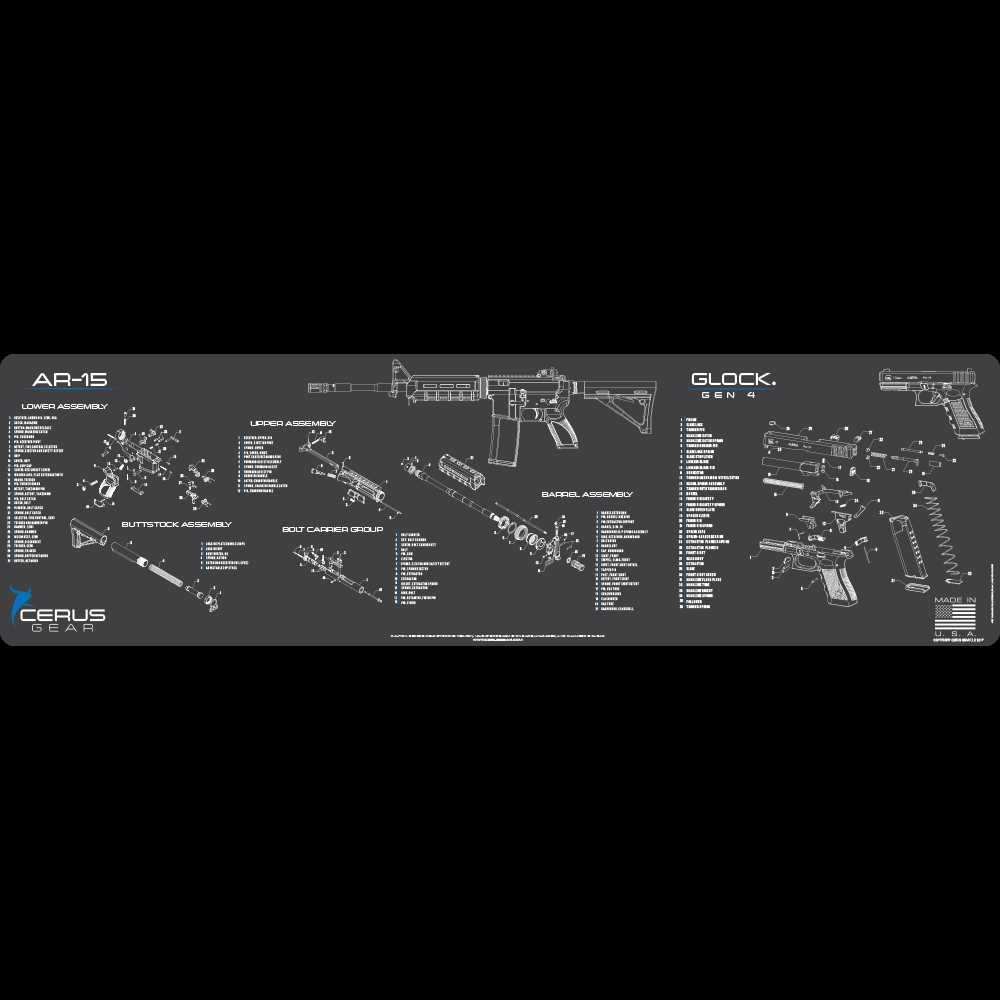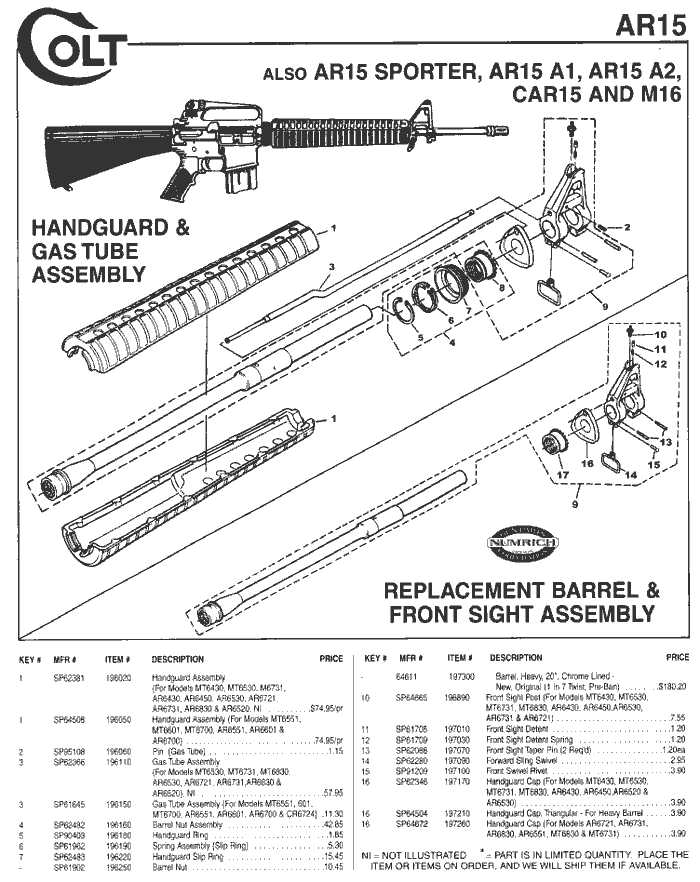
The AR-15 platform has become a significant topic of discussion among firearms enthusiasts and professionals alike. Its modular design allows for a wide range of customizations and configurations, making it appealing for various uses, from sport shooting to self-defense. Grasping the intricate details of this firearm’s construction is essential for both new and seasoned users, as it can enhance one’s understanding of functionality and performance.
Every element plays a critical role in ensuring reliability and accuracy. By dissecting the various sections of this weapon, individuals can appreciate the craftsmanship and engineering that contribute to its success. Each component interacts harmoniously, creating a seamless experience when handling the firearm. From the action mechanism to the housing structure, knowledge of these intricacies fosters a deeper connection between the user and their equipment.
Furthermore, exploring the different features can illuminate the potential for personalization and adaptability. Understanding how each section functions and contributes to the overall system empowers users to make informed decisions regarding upgrades and modifications. This awareness not only enhances performance but also aligns the firearm with the specific needs and preferences of its owner.
Understanding the AR-15: Key Components
The AR-15 is a versatile firearm renowned for its modularity and adaptability. Understanding its essential elements is crucial for both enthusiasts and users alike. Each component plays a significant role in the overall function, accuracy, and usability of the weapon, contributing to its reputation as a reliable choice for various applications.
The upper receiver houses the barrel and bolt carrier group, crucial for the firing mechanism. The lower receiver contains the trigger assembly and is the central part of the firearm, serving as the foundation for assembly. Additionally, the stock and grip enhance comfort and control, allowing for better handling during operation.
The gas system, which includes components like the gas block and tube, is integral to cycling the action and ensures efficient operation. Understanding how these elements interact can significantly improve performance and maintenance practices.
By familiarizing oneself with these critical aspects, users can appreciate the engineering behind the AR-15 and make informed choices regarding modifications and upgrades to suit their specific needs.
Overview of AR-15 Functionality
The AR-15 operates through a sophisticated mechanism that combines various elements to achieve efficient firing and reloading. Understanding this interplay enhances appreciation for the design and performance of this firearm.
Operational Mechanism
At its core, the system utilizes a gas-operated action, which channels gases from fired cartridges to cycle the action. This results in quick reload times and improved reliability in diverse conditions.
User Interaction
The overall handling experience is refined, with ergonomic features that facilitate ease of use. Shooters can customize controls and accessories, allowing for enhanced comfort and adaptability in various scenarios.
Main Parts of the AR-15 Explained

The AR-15 is a complex firearm that embodies a variety of crucial components working in harmony. Understanding its essential elements enhances both usage and maintenance, allowing enthusiasts and operators alike to appreciate the intricacies of this versatile weapon. Each section plays a significant role in the functionality and performance of the rifle.
The receiver serves as the heart, housing critical mechanisms for operation. The barrel, integral to accuracy, directs the projectile with precision. The stock provides stability and comfort, ensuring effective handling. Meanwhile, the handguard protects the user from heat and offers space for accessories. Additionally, the firing mechanism is pivotal, converting the trigger pull into the firing action, ensuring reliability in various conditions.
Overall, recognizing these components fosters a deeper connection to the AR-15, ultimately enriching the experience for users, whether on the range or in the field.
How the Gas System Works
The gas operation within a firearm is a crucial element that enables efficient cycling of the action. This mechanism harnesses the energy generated from firing a cartridge to automate the reload process, enhancing overall performance and reliability.
At its core, the gas system relies on the following components:
- Gas Block: Directs the gas into the operating system after a round is fired.
- Gas Tube: Transports the gas from the block to the bolt carrier group.
- Bolt Carrier Group: Houses the bolt and is responsible for chambering the next round.
The sequence of operations begins when a round is discharged:
- As the bullet travels down the barrel, a portion of the gas escapes through a port.
- This gas enters the gas block, where it is redirected into the gas tube.
- The pressurized gas travels through the tube, pushing the bolt carrier group rearward.
- The rearward movement ejects the spent casing and chambers a new round.
This system not only improves the rate of fire but also minimizes recoil, making it an effective choice for various shooting applications. Understanding this mechanism allows users to appreciate the efficiency and reliability of their firearms.
Importance of the Upper Receiver
The upper receiver serves as a critical component in the overall functionality of a firearm, influencing both performance and user experience. It houses several essential mechanisms that work together to ensure reliable operation and accuracy. Understanding its significance helps enthusiasts appreciate the intricacies of firearm design.
Key Functions of the Upper Receiver

This section outlines the primary roles that the upper receiver fulfills in a firearm’s operation:
| Function | Description |
|---|---|
| Chambering | Facilitates the loading of cartridges into the chamber for firing. |
| Gas System | Controls the expulsion of gases generated during firing to cycle the action. |
| Rail System | Provides a mounting surface for optics and accessories, enhancing versatility. |
| Barrel Attachment | Connects the barrel to the receiver, ensuring stability and accuracy. |
Impact on Performance
The design and quality of the upper receiver can significantly impact accuracy, reliability, and overall performance. A well-crafted upper receiver contributes to smooth operation, while any deficiencies may lead to malfunctions. Therefore, attention to detail in this component is vital for firearm enthusiasts and users alike.
Lower Receiver: What You Need to Know
The lower receiver serves as the foundational element of the AR-15, playing a crucial role in its overall functionality. This component houses essential mechanisms and provides the necessary structure to support various attachments. Understanding its significance is vital for anyone interested in firearm construction or customization.
Construction and Materials are key aspects of the lower receiver. Typically crafted from durable aluminum, this element ensures strength while keeping the overall weight manageable. The choice of material contributes to the reliability and longevity of the firearm, making it an important consideration for enthusiasts.
Functionality is another critical factor. The lower receiver accommodates the trigger assembly, magazine well, and other integral systems that allow for effective operation. Its design influences the shooting experience, affecting aspects like accuracy and ease of handling.
Customization options abound for the lower receiver, enabling users to tailor their firearms to specific preferences. From different finishes to ergonomic grips, the choices available can significantly enhance both performance and aesthetics. Understanding these options can empower shooters to create a personalized experience.
In conclusion, the lower receiver is more than just a component; it is a vital part of the AR-15’s identity. Familiarity with its characteristics and functions can greatly enhance one’s appreciation and knowledge of this versatile firearm.
Accessories and Customization Options
Enhancing your firearm involves a multitude of choices that cater to both functionality and personal style. From improving performance to reflecting individual preferences, the array of enhancements available allows enthusiasts to tailor their weapons to suit specific needs and aesthetics.
Functional Additions

Upgrades that enhance usability are often prioritized. Items such as optics improve accuracy, while grips can provide better control during use. Furthermore, muzzle devices help in managing recoil and flash, making shooting more comfortable and precise. Each addition plays a crucial role in maximizing the weapon’s potential.
Aesthetic Customizations
Beyond functionality, visual appeal is an essential aspect of personal expression. Paint finishes, cerakote options, and unique accessories enable users to showcase their identity. Additionally, custom stocks and handguards can significantly alter the look and feel of the firearm, creating a unique blend of style and performance.
Common Misconceptions About AR-15s
The AR-15 platform often encounters various misunderstandings that can skew public perception. These misconceptions can arise from misinformation or a lack of knowledge about the firearm itself.
- Assumption of Automatic Fire: Many people believe that AR-15s are automatic weapons. In reality, they are semi-automatic, meaning each trigger pull results in a single round being fired.
- Misunderstanding of Usage: Some think AR-15s are only suitable for military or tactical use. However, they are also popular among sport shooters, hunters, and recreational users.
- Belief in High Danger: The notion that AR-15s are inherently more dangerous than other firearms is misleading. The risk associated with any firearm depends more on the user and the context rather than the weapon itself.
- Perception of Complexity: Many believe that the AR-15 is overly complex to operate or maintain. In fact, many find it user-friendly and easy to customize according to individual preferences.
Addressing these misconceptions is crucial for fostering a more informed discussion about the AR-15 and firearms in general.
Maintenance Tips for Longevity
Ensuring the durability and reliability of your firearm requires consistent care and attention. Regular upkeep not only enhances performance but also extends its lifespan significantly. Here are some essential practices to keep in mind.
- Regular Cleaning: Make it a habit to clean your equipment after each use. This prevents residue buildup and corrosion.
- Proper Lubrication: Use appropriate lubricants to reduce friction and wear. Apply sparingly to avoid attracting dirt.
- Inspection: Periodically check for wear and tear. Look for signs of damage or loosening components and address issues promptly.
Implementing these strategies will help maintain functionality and reliability over time.
- Storage: Store your equipment in a controlled environment to protect it from moisture and temperature extremes.
- Avoid Overuse: Be mindful of usage frequency. Excessive handling can lead to unnecessary wear.
- Seek Professional Help: If you’re uncertain about any aspect of maintenance, consult a professional for guidance.
By adhering to these tips, you’ll ensure your firearm remains in excellent condition for years to come.